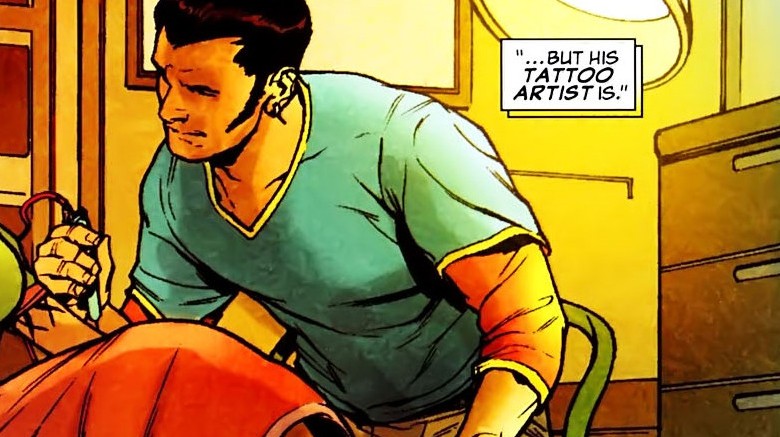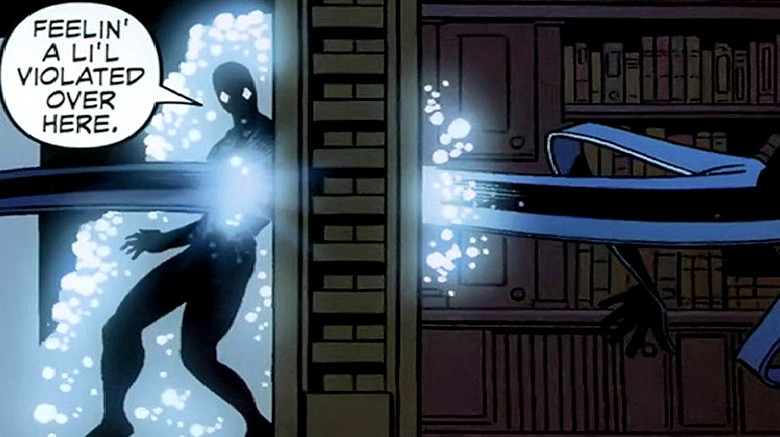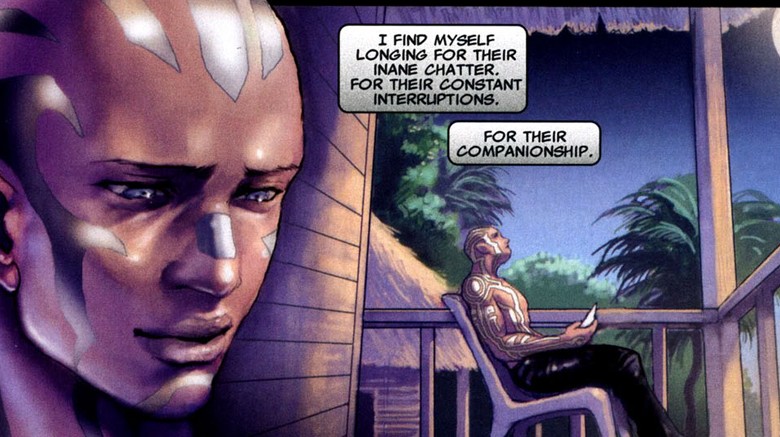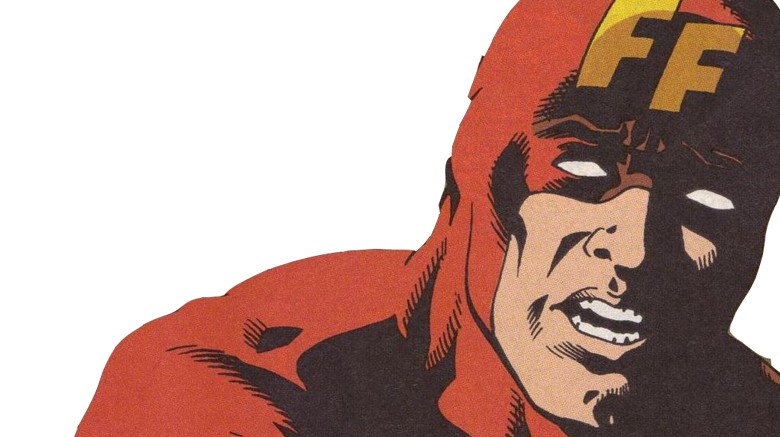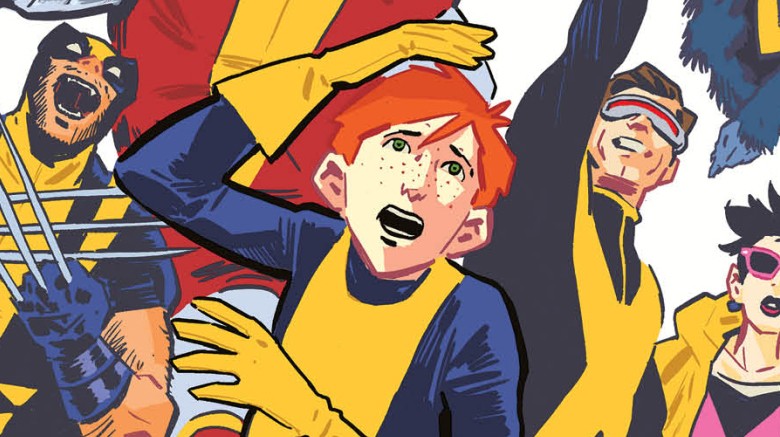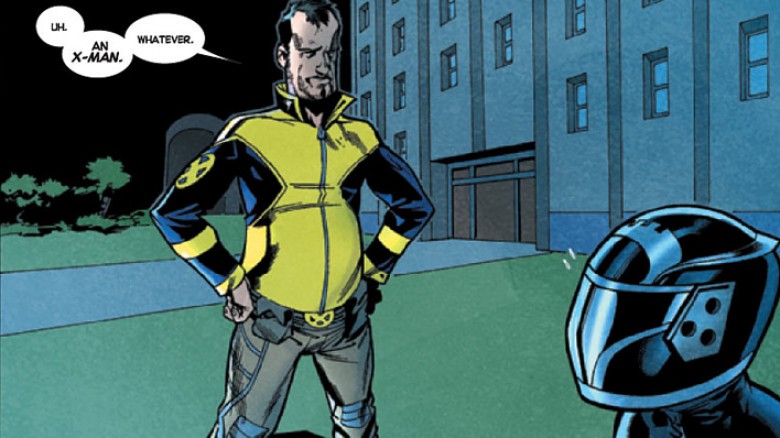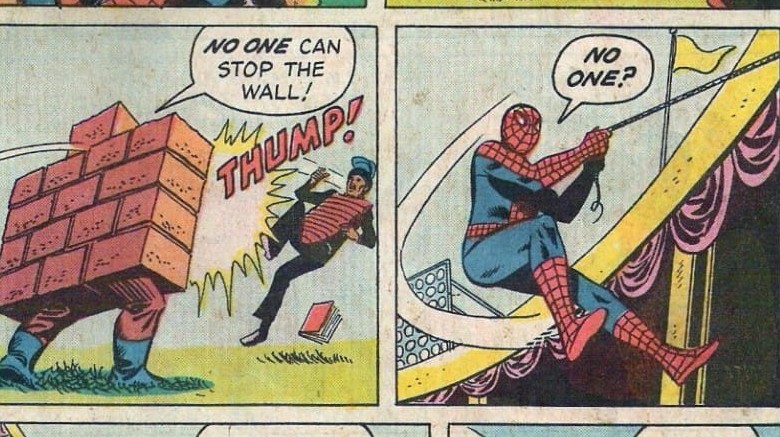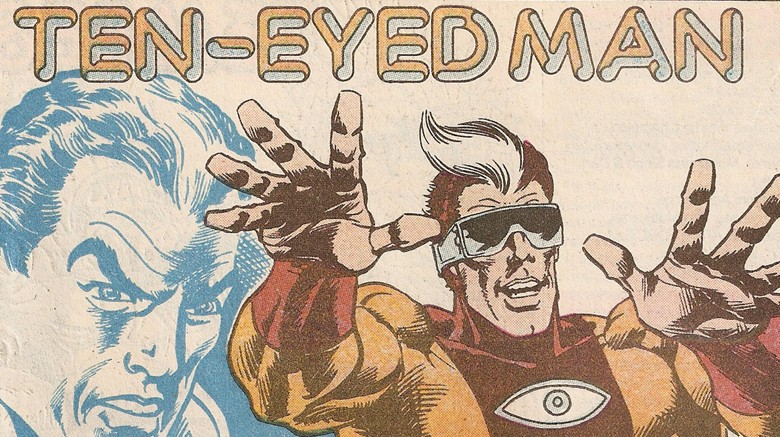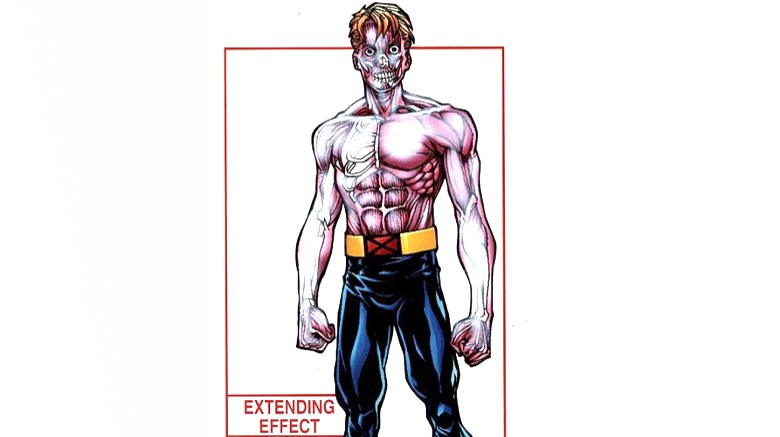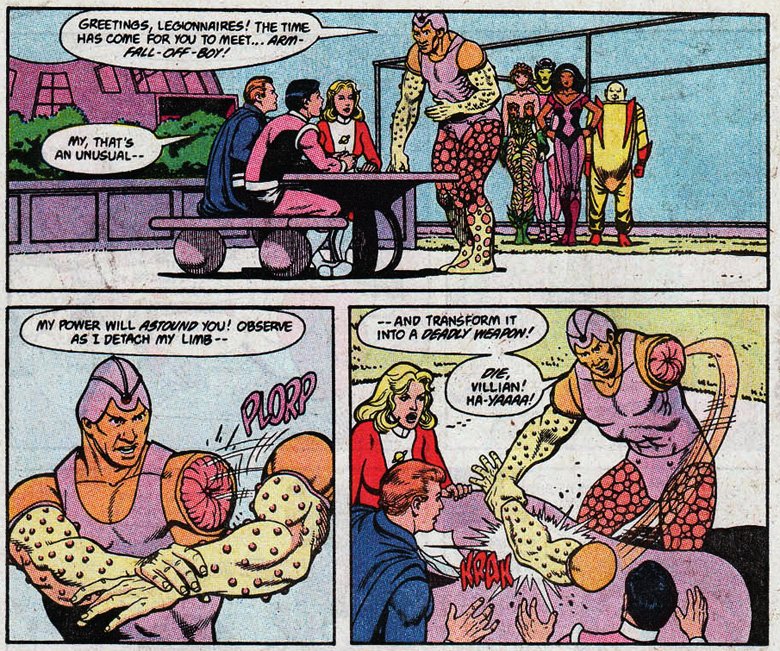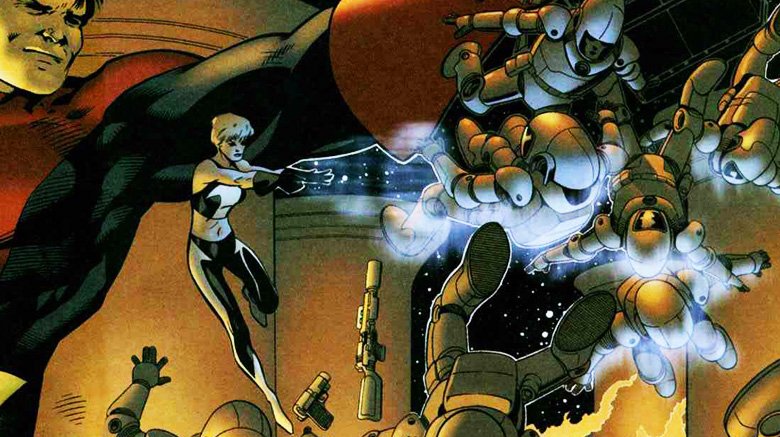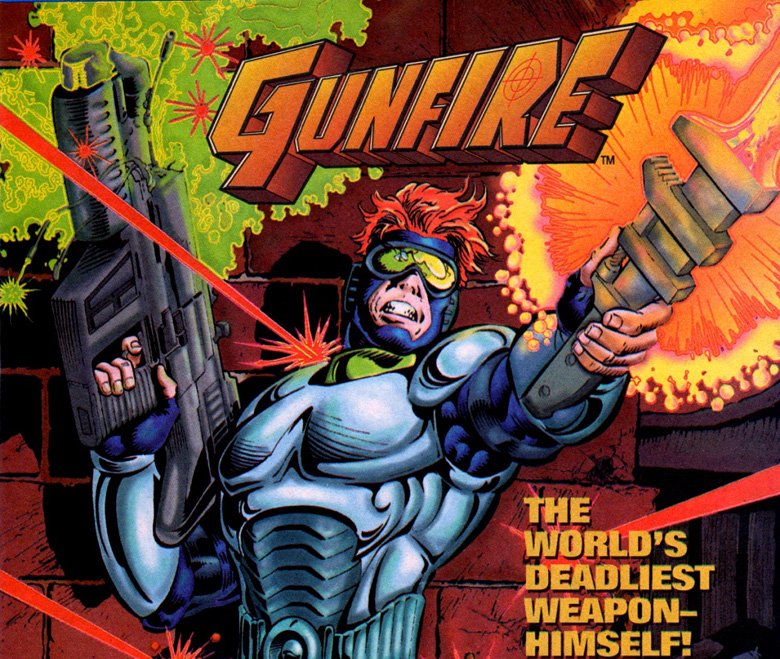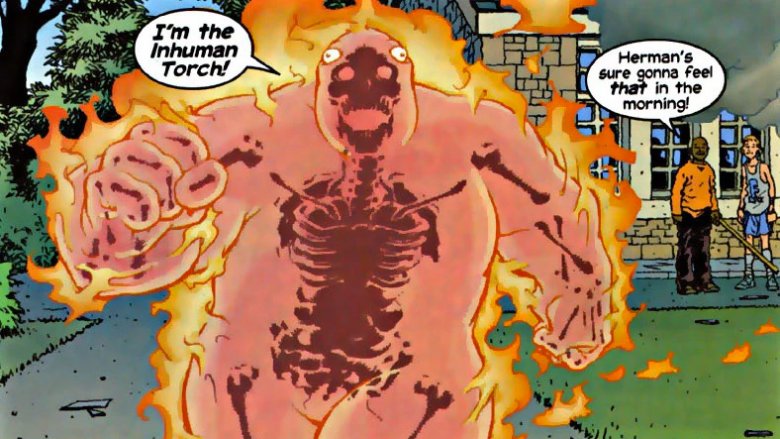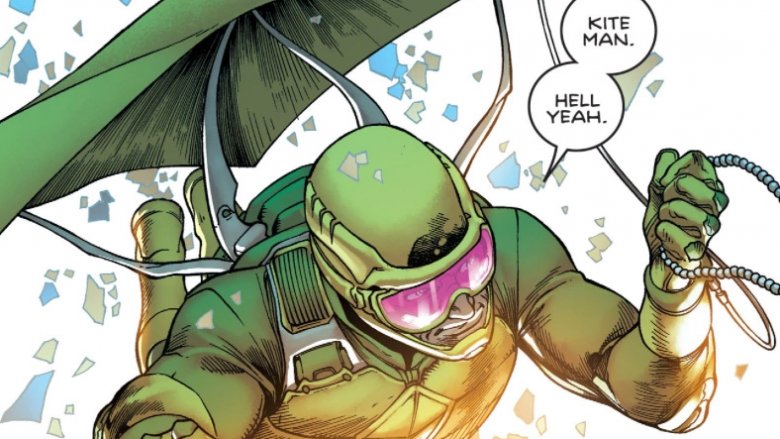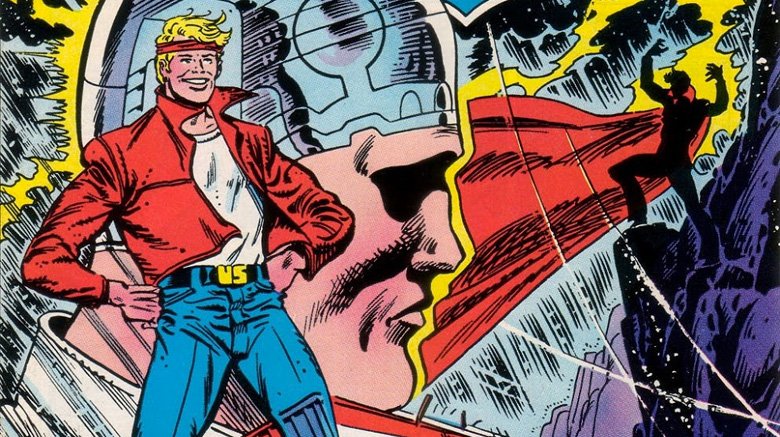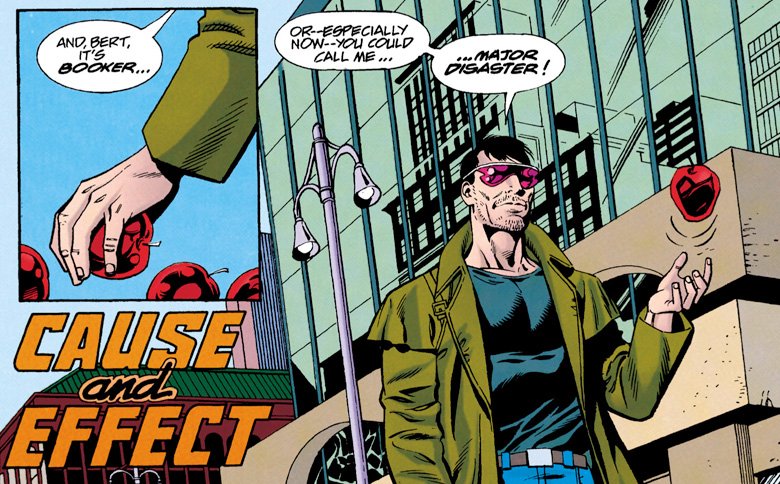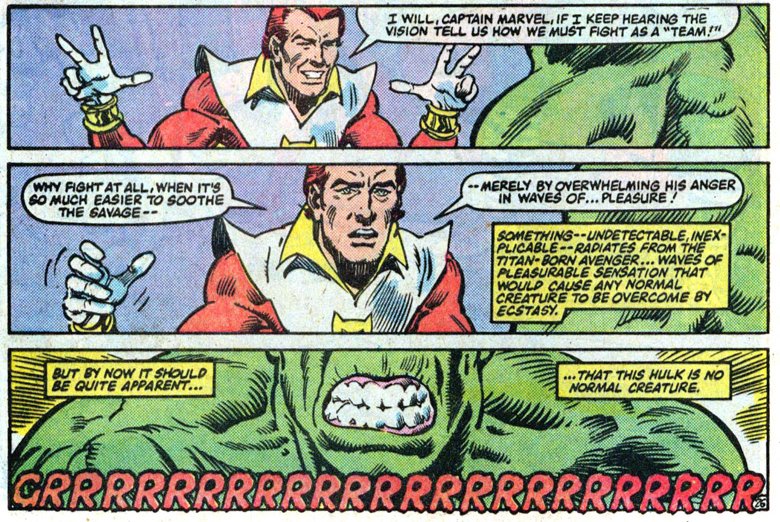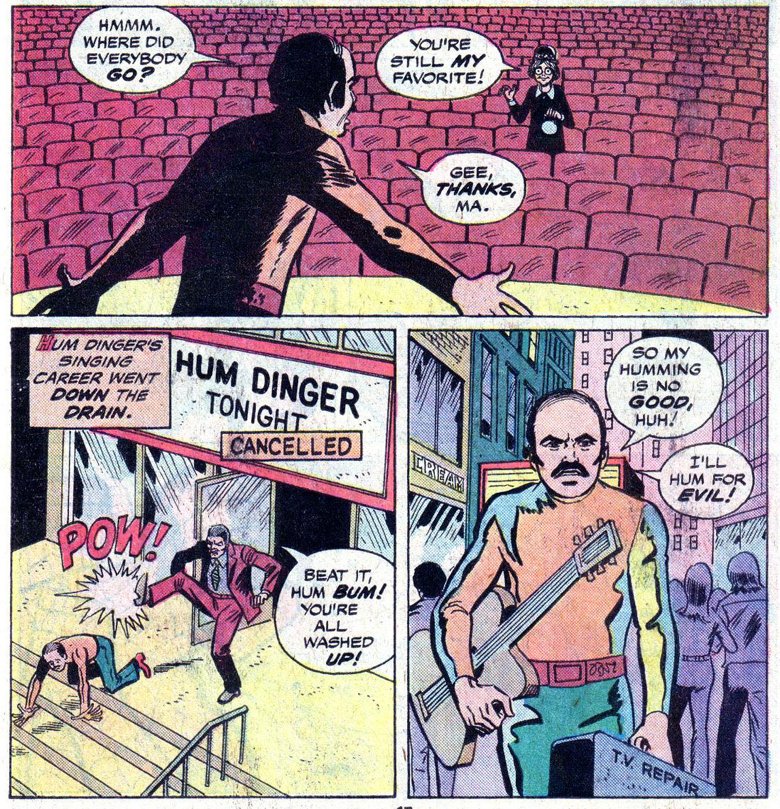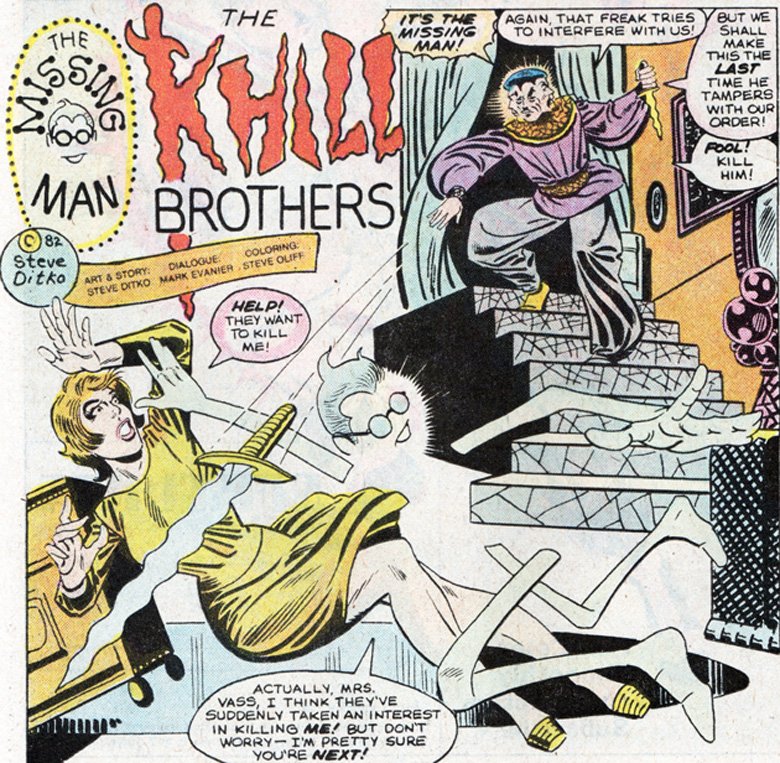The Most Useless Superpowers
The comic world is littered with heroes possessing various god-like abilities. Heroes who could end all life as we know it with a thought, punt a hospital into orbit, or fart tornadoes. But for every hero with powers like these, there are heroes who couldn't even receive the short end of the stick without getting a splinter. Heroes with "superpowers" so specific in their nature or unwieldy that they're next to useless, heroes ...
Leon Nunez
Leon Nunez is a Marvel character so lame he doesn't even have a superhero alter-ego, and his power is so awkward, its explanation on the Marvel wiki is almost as long as his entire character biography.
In a nutshell, Nunez is a mutant with the ability to give other people superpowers, via tattoos that roughly correspond to that power. So, if Nunez wanted to grant someone the ability to fly, he'd give them a tattoo of some wings, or if he wanted them to be able to shotgun Jägermeister, he'd give them a tramp stamp. You may notice that giving someone a tattoo is an incredibly convoluted and time-consuming process, meaning Nunez is next-to-useless in an actual fight, unless you give him 3 weeks notice and know exactly what you're up against.
On top of this, every time Nunez gives someone a magic tattoo it requires a portion of his "will" to work, meaning every tattoo slowly saps away at his own strength, as shown in the first nine issues of the Young X-Men series. When the limit of his power is reached, Nunez will fall into a coma and die. For some reason, Nunez never tries to tattoo himself, so his actual story arc in the comics is that he gives 100 random people new superpowers, falls into a coma, and is promptly never heard from ever again.
Doorman
This Marvel "hero" has powers roughly analogous to Nightcrawler, the original BAMF. However, unlike Nightcrawler, who can teleport himself and an unclear amount of extra stuff an almost infinite distance at will, Doorman can only teleport people to ... the next room, hence the wholly unthreatening name, Doorman.
Technically, Doorman's body functions as a portal to a mysterious dimension filled with Iron Maiden album covers, that can transport people through any solid object Doorman stands against, as shown in the hilarious G.L.A.: Misassembled miniseries from 2005. This, despite sounding cool, is still a fairly useless ability in a world where Juggernaut and actual doors exists. The worst part is, Doorman can't even control this power, meaning people can pass through him against his will by simply walking into him, preferably with their middle finger raised to rub it in.
In Great Lakes Avengers #4, Doorman was eventually killed and resurrected with a host of extra powers, such as the ability to transcend death, be immune to harm, and summon a magic pair of skis. None did anything in the way of elevating his position in the Marvel hierarchy, because nobody can respect a hero whose main ability can be replaced by the thing that killed Leonardo DiCaprio in Titanic.
Spot
Spot is a Spider-Man villain with the ability to to create tiny inter-dimensional doorways from the spots on his body. Spot can control the size of these doorways, and they can seemingly transport any amount of matter over a cast distance instantaneously. Spot uses this ability to walk through walls, avoid using the stairs, and layeth the smacketh down on Spider-Man from a city block away. Spot also probably uses his powers to drop his turds from orbit onto Avengers Tower, because that's sure as hell what we'd do if we had his powers.
On paper, Spot's power is pretty great, being powerful enough to trump Spider-Man's spider-sense due to its unpredictability, as it did in Amazing Spider-Man #589. However, since Spot only has human-level strength and reflexes, while he could theoretically cold-cock any superhero he wanted, he could never actually do any real damage to them. This isn't to mention how Spot looks kind of goofy, and has a supervillain name only mildly less threatening than Fido or Clifford. Bad dog, no awesome powers!
Gentle
Gentle is a mutant from the Marvel universe with the ability to become infinitely buff at will, giving him the potential for limitless strength. Essentially, Gentle can expand his own muscle mass, dramatically increasing his strength and durability while reducing his ability to find T-shirts that fit. The buffer Gentle allows himself to become, the stronger he is, which sounds pretty sweet, right? The comics even note that there's no conceivable limits to Gentle's buffness, meaning he could theoretically go toe-to-toe with the heaviest hitters in the Marvel universe, fight the Hulk to a standstill, or backhand Thor through a brick-wall.
The thing is, Gentle's powers are kept in check by special vibranium tattoos all across this body that prevent him from becoming too buff. The comics note that every time Gentle roids out and uses his powers, his baseline strength increases, which is an issue because his tattoos will eventually be unable to hold back his rippling biceps and sick-ass delts. This means that Gentle is destined to die like the rattiest of all gym-rats: exploding in a mass of hypersonic bone fragments and testosterone from flexing just that little bit too hard.
Friendly Fire
Friendly Fire is a DC hero who fought alongside a team of heroes known as Section 8. He has the ability to shoot powerful concussive laser blasts from his fist, strong enough to blow someone's head clean off. We know this because Friendly Fire is killed shortly after his debut, when he misses his target and blows his own clean head off with one of his laser blasts. Can't win 'em all. Or in his case, any.
Prior to this, Friendly Fire's power is shown to be a massive hinderance to his team, as it seemingly only has the ability to harm his own teammates. This inexplicably surprises them, despite Friendly Fire's name kind of being a dead giveaway that he's not going to be of much as an asset to a fight as say, Dogwelder. Friendly Fire dies with a negative kill-death ratio, having failed to ever hit a single enemy in battle and after injuring half his own teammates by laser-punching them by accident.
Bailey Hoskins: the worst X-Man ever
That title isn't us being sarcastic — that's literally the way he's described in his first comic appearance, and when your official debut into a universe where Cyclops exists is the comic telling you that you're the worst X-man, you know you suck more than a nuclear-powered vacuum cleaner.
Basically, Hoskins is a mutant with the ability to detonate his body at will, with enough force to level a city, turn the Hulk into a pink smear or even destroy the entire world. One power Hoskins doesn't have, though, is the ability to survive this explosion, meaning he can't actually ever use his powers without killing himself and everyone around him. Professor X feels so bad for Hoskins in the comics, he gives him a suit of power-armor so he can actually help out during fights ... and presumably to stop him turning the X-Mansion into a smoking crater by pouting too hard.
ForgetMeNot
ForgetMeNot is a mutant with the power of imperceptibility, which is just a fancy way of saying he has the power of being so unremarkable you instantly forget he exists. ForgetMeNot's power makes it so the moment he leaves someone's perspective, he ceases to exist to that person, with all memories of his existence being instantly and permanently erased.
The comics mention that ForgetMeNot was actually a member of the X-Men for six years before someone finally realized he existed, because the toilet paper kept going missing in the X-Mansion. When your own turds are more noticeable to your comrades than you are, there's a chance your power isn't all that useful to the team. Then again, it is mentioned that ForgetMeNot gets to ride trains for free because nobody can see him, so yeah, rough with the smooth and all that.
The Wall
This is an old, obscure Spider-man villain with a similar backstory to Sandman, only instead of being a small-time crook-turned-sentient cloud of sand, Waldemeyer is a teenager who was exploded so hard by a bomb he turned into a walkin', talkin' stack of bricks. We should probably mention that this particular villain hails from the earlier, stupider days of comic books.
As you can probably guess from his name and the glorious picture two inches above this sentence, THE WALL possesses all of the strengths of a sentient piece of concrete. These powers includes superhuman strength, durability, and bizarrely enough, the ability to control the minds of baseball umpires. All for the low, low cost of sacrificing his ability to form meaningful human connections ever again, and having no arms. What a bargain!
Ten-Eyed Man
Ten-Eyed Man is a Batman villain with eyeballs where his fingertips should be. In real life, this would make Ten-Eyed Man a wreck of a human being who only knew how to communicate via screaming. In comics, however, it makes him powerful enough to square off against a man who has a file in his desk detailing how to beat up Superman.
To be clear, Ten-Eyed Man has no superpower beyond having 10 eyes, all of which are located on his fingertips. Hell, he doesn't even have regular eyes to back up these extra eyes, because he was blinded in an explosion. Despite this, Ten-Eyed Man decided to inexplicably become a supervillain and antagonize Batman. Because comics are dumb, Ten-Eyed Man actually manages to beat the Dark Knight in at least one fist fight, even though to throw a punch, Ten-Eyed Man has to blind himself. So we guess this power isn't all that bad, if you're okay with being potentially killed by a papercut or something.
Wraith
Wraith is a fairly unique example of a Mutant, in that he's one of the few whose powers never fully manifest themselves. The comics note that Wraith's power seems to be the one all horny teenage boys would give their left sac for: invisibility. However, for some reason, Wraiths powers never fully realize themselves, leaving him with the entirely useless ability to turn his skin — and only his skin — invisible. Seemingly just to rub it, the X-Gene in Wraith's body doesn't even let him control this power, meaning he has to walk around all the time looking like a fleshly skeleton.
Wraith's appearance is so unsettling, the first X-Men comic panel he appears in shows him being beaten half to death by a crowd of people for looking like a horrible monster. Wraith's ability to turn invisible is such a non-power, it actually makes him more visible to people, while simultaneously giving him no ability to defend himself from even most the ineffectual slaps of a half-hearted angry mob whom you know weren't putting any real effort into it.
Arm-Fall-Off Boy
It might be cheating a little bit to include characters who were obviously created as jokes, but no list of useless superpowers would be complete without a spotlight on the amazing Arm-Fall-Off Boy.
See, in order to accommodate their ever-expanding roster, the 31st Century's Legion of Super-Heroes would hold occasional tryouts where aspiring Legionnaires could audition for the team. A few became full-fledged teammates, meeting the high standard set by Legionnaires like Matter-Eater Lad and Bouncing Boy, but the vast majority were rejected, and while a few of them would find some small measure of fame as the misfits of the Legion of Substitute Heroes, most were goofy one-offs who quickly faded into obscurity.
Arm-Fall-Off Boy, on the other hand, was one of the few rejects whose power was so monumentally goofy that he he's actually made a few comebacks over the years. Introduced in Secret Origins #46 as part of a story that also reveals that the Legion's headquarters is actually Fortress Lad, a kid who could turn into a building but forgot how to turn back, he has the power of making his arms fall off and then hitting people with them. It might not be that impressive compared to, say manipulating the laws of physics or controlling your opponent's mind, but if you saw someone tear their own arm off and start swinging it like a baseball bat, you'd probably be way too terrified to continue committing space crimes.
Light Lass
It's not just the Legion rejects who wound up with useless powers. Occasionally, someone would make it onto the actual team with something wielding the superheroic equivalent of a screen door on a submarine. The prime example of that is Ayla Ranzz, Light Lass, who possesses the fearsome, awe-inspiring ability of ... making things less heavy.
Admittedly, plenty of creators over the years have done their level best to do some fun things with it, but at the end of the day, it's just not that useful, especially compared to everyone else on the team. It's bad enough that she's less useful than the guy who can eat rocks, but she's also on the team with Star Boy, whose ability to make things heavier is a far more useful version of mass manipulation.
The worst part? When Ayla joined the team, she actually had a much cooler power. She was originally Lightning Lass, with the ability to shoot electricity out of her hands, and filled the spot left vacant when her brother, Lightning Lad, died. After he returned from the dead, however — because, you know, comic books — a rule in the Legion's charter about not having two members with the same power led one of her teammates to zap her with a machine that swapped lightning for lightening, without ever actually asking her if that's what she wanted. On the bright side, if you ever need someone to help you move, she's definitely the hero to call.
Gunfire
In 1993, DC launched an event called Bloodlines that was designed to bring a whole roster of edgy new characters into their universe by having a bunch of alien bugs show up and experiment with random humans. The story was spread across 23 issues of different titles, each of which introduced an extreme new hero or villain. As you might expect, it produced exactly one character that you could consider a success: Hitman, a mildly superpowered killer who starred in a 60-issue series by Garth Ennis and John McCrea that's still regarded as one of the decade's best superhero comics.
The extremely distant second-place honor goes to Gunfire, who managed to survive for 14 issues with the most '90s superpower ever: he can turn anything he touches into a gun. On the surface, that's not actually a bad idea by itself. It's explained in the story as agitating molecules, which is essentially what Gambit does to turn everything he touches into a bomb. The problem is that we already have Gambit, and while comics fans accepted one character with gnarly kinetic-energy-explosion powers, two was a bit much. Also, for some reason, Gunfire carries a regular gun, which is kind of like the Flash riding around on a moped.
It's surprising that Gunfire has never found his way back to the DC Universe, but Ennis and McCrea put a pretty solid nail into his coffin in the pages of Hitman #1,000,000, an issue set in the distant future where an aspiring hero gave himself Gunfire's powers and ended up killing himself right after uttering the immortal words "Oh God, I turned my a** into a hand grenade!"
Glob Herman
For a while there, it didn't seem like there was much of a downside to being a mutant in the Marvel universe. Sure, you may have been hated and feared by people who built giant purple robots made of racism to kill you, but in the '90s, everyone you saw on the page was a beautiful, super-ripped hero surrounded by equally beautiful people. Even the Beast looked cool, and he was the one who was meant to have turned himself into a monster.
When Grant Morrison and Frank Quitely arrived in 2001 for New X-Men, however, one of their goals was to bring back the idea of the Xavier School taking in all mutants, not just the ones with powers that made for an exciting action story. That's how we ended up with characters like Glob Herman, a rotund teenager whose skin was not only transparent, giving him visible bones and organs, but also composed of a substance that was frequently compared to paraffin wax.
Unfortunately for Glob, paraffin wax is pretty flammable, which is why it's frequently used for making candles. That's something that he might've wanted to consider before joining in with a student riot at Xavier's and getting set on fire. It turns out that being a giant wax-covered skeleton that's easy to set on fire isn't exactly a great asset for the X-Men's action-packed pursuits, but it's fine. He survived and — perhaps surprisingly — is still kicking around that merry mutant corner of the Marvel Universe.
Kite Man
It takes a lot of confidence to commit a crime in Gotham City. Just looking at the logistics and the risk-reward ratio, you have to realize that the chances of ending your night counting up your freshly stolen cash are vastly outweighed by the odds that you'll get multiple concussions from a guy dressed as Dracula who's so good at karate that they let him in the Justice League. Then again, maybe you think that this time, you've got the edge, whether it comes from your freeze gun, your fiendishly clever riddles, or, if you're Charles Brown, your ability to hang glide and fly kites pretty well.
Yes: Kite Man's actual name is Charlie Brown, named for the comic strip character who famously can't keep a kite in the air for more than two panels. And if that wasn't insulting enough, here's the last sentence from his entry in Who's Who, the official guidebook to characters in the DC Universe: "He is a poor leader and an even poorer hand-to-hand combatant." Ouch.
Kite Man has been revived in modern Batman comics, getting a new catchphrase — "Kite Man, hell yeah!" — and a hilariously grim-and-gritty new origin story that involves the Joker killing his son, who just loved kites. Alas, none of this makes you better at not getting punched out by Batman.
Ulysses Solomon Archer
U.S. 1 is one of those comics that always comes up whenever snarky writers talk about the worst and weirdest obscure superhero books, but here's the thing: if you read that comic, it's actually pretty great. Writer Al Milgrom and artists Herb Trimpe and Frank Springer were clearly fully aware that they were doing something ridiculously goofy.
Of course, they had to be. U.S. 1 was, after all, a licensed toy comic that was meant to tie into a remote-controlled big rig. That's not exactly the sort of thing that brings in the grand, sweeping mythology of Transformers or the endless array of characters you got from G.I. Joe. Thus, they did the only thing they could and created Ulysses Solomon Archer, a kind-hearted trucker who got a metal plate in his head after a crash and gained the incredible ability to telepathically control his 18-wheeler. He couldn't control every semi truck, just his own. And that's not the weird part.
No, the weird part is that there was one issue that was actually narrated by the truck itself, in the only time in the book's 12-issue run that it was even hinted at that the truck might be sentient. Still, it's a good enough superpower to give him occasional cameos in the wider Marvel Universe, showing up any time someone needs a trucker who can drive in outer space. Which, believe it or not, comes up surprisingly often.
Major Disaster
In theory, Major Disaster's powers are awesome. After originally being created as a villain who uses super-scientific weapons to create earthquakes, floods, and other natural disasters, he got a new set of powers in DC's 1995 Underworld Unleashed crossover. A deal with the demonic Neron gave him the power to manipulate cause-and-effect around him, playing off trendy new ideas about chaos theory.
The end result of this was that there were two or three genuinely great issues where Major Disaster would use seemingly inconsequential events to set off elaborate chain reactions to get what he wanted. In Flash #125, for instance, he deals with an annoying conversation by throwing a sandwich, which causes a dog to chase it, which pulls a bag of groceries out of its owner's hand, which spills a bunch of apples into the path of a bike messenger, who loses control and sends his bike crashing into a pedestrian, which pushes him into the path of an oncoming bus, which swerves to avoid him and winds up crashing into the annoying guy Major Disaster wanted to kill.
It's a really cool power, but it's also one that's hard to write, requiring creators to think up (and then draw) complicated Rube Goldberg setups that all connect together but that can still provide a challenge for someone who can run at the speed of light. That's probably why Major Disaster's chaos theory powers ended up being ignored in future appearances. It turns out the coolest superpower in the world is still pretty useless if nobody wants to write about it.
Starfox
Starfox is ... problematic. Maybe even more problematic than his brother Thanos, and considering Thanos once literally killed half the universe, that's saying something.
He's got the standard set of powers that you see in the Eternals of Titan — super-strength, invulnerability, all that good stuff — but his big gimmick is psionically stimulating people's pleasure centers in order to send them into euphoria. In other words, he's a walking hit of ecstasy, which has led to storylines where he's been put on trial for sexual assault on account of being unable to turn those powers off when he's interacting with people. He's also been indirectly, inadvertently, and non-consensually causing two other characters to fall in love with each other.
Even if you can get past that pretty dark, extremely uncomfortable interpretation of his powers, he hasn't exactly had the greatest track record in actually using them as a superhero. In Hulk #300, he experiences what might be his defining moment when he attempts to overwhelm a rampaging, mindless Hulk with "waves of pleasure." For his trouble, he gets punched so hard that he lands three blocks away.
Hum Dinger
The Wall isn't the only truly amazing villain to spring from the pages of Spidey Super Stories. It was, after all, a title for young readers where even characters like Dr. Doom were presented as goofballs with wacky schemes, so you know the original villains are going to be weird.
Case in point: Hum Dinger, a would-be musician whose bad memory led him to hum onstage. While this initially went over pretty well with his audience — which is honestly the most unbelievable part of the story, up to and including the guy who has spider powers showing up and shooting webs out of little bracelets — his fame quickly went sour, and he decided to hum for evil.
That's it. He wasn't, like, supernaturally good at humming or anything, he was just really, really annoying, and people gave him money to make him go away. It's not exactly the kind of situation that you'd think would require intervention from Spider-Man, but hey, the '70s were a weird time.
Missing Man
As the co-creator of characters like Spider-Man and the Question, Steve Ditko's contributions to the history of comic books are both important and pretty well-chronicled. His later creations, however, not so much, whether it was the incomprehensible adventures of hard-line objectivist Mr. A, or the string of bizarre vigilantes like the aptly named Odd Man.
The Missing Man, who made his debut alongside the Rocketeer in 1983's Pacific Comics Presents #1, is one of those weirdos. In his handful of increasingly weird appearances, his name is variously given as Syd Vane and Syd Mane, and he battles crime with the uncanny power to not have a torso. He's just a pair of spindly arms and a couple of cartoony legs capped off with a slightly unfinished face and big glasses.
If you need more information than that, well, there isn't any. It seems that along with a body, the other big missing piece of Missing Man was any explanation whatsoever for what his entire deal was.
